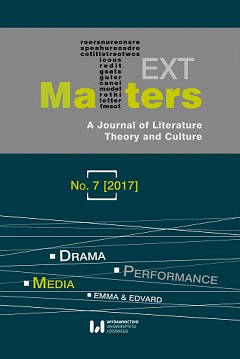Flaubert’s Provocation
DOI:
https://doi.org/10.1515/texmat-2017-0003Keywords:
Madame Bovary, novel, condition of women, provincial life, narrative techniqueAbstract
Madame Bovary, which was scandalous in its own day for its focus on the adultery of a provincial woman, has had a strange, complex fate. Flaubert remade the image of the novelist, as pure artist, for whom style was all that mattered, and disrupted novelistic technique, in ways that critics and writers have found exemplary, treating this as the novel novelists cannot overlook; yet for readers Madame Bovary is not a “book about nothing” but provides a searing portrait of provincial life and of the condition of women. The vividness and complexity of the character Flaubert created here made Emma a type: a sufferer of “Bovarysme.” Flaubert’s revolutionary notion that a trivial subject was as good as a noble subject for a serious novel was taken to be connected to the democratic notion that every human subject is as worthy as another and allowed to have desires. Yet, while promoting Emma as a valid subject of literature, equal to others, Flaubert writes against the attempt to democratize art, to make it enter every life, and renders trivial the manifestations of this subject’s desires, while making her an exemplary figure.
Downloads
References
Allen, Woody. “The Kugelmass Episode.” Side Effects. New York: Random, 1980. 41–56. Print.
Google Scholar
Bal, Mieke. “Over-writing as Un-writing.” A Mieke Bal Reader. Chicago: U of Chicago P, 2006. 96–145. Print.
Google Scholar
Bal, Mieke and Michelle Williams Gamaker. Madame B: Explorations in Emotional Capitalism. Video Exhibition. Cinema Suitcase, 2012–14.
Google Scholar
Baudelaire, Charles. “Madame Bovary de Gustave Flaubert.” Oeuvres complètes. Paris: Gallimard, 1961. 647–57. Print.
Google Scholar
Culler, Jonathan. Flaubert: The Uses of Uncertainty. Ithaca: Cornell UP, 1984. Print.
Google Scholar
d’Aurevilly, Barbey. Rev. of Antoine Quérard, by Charles Bataille and Ernest Rasetti. Les OEuvres et les hommes: IV. Les Romanciers. Paris: Amyot, 1865. Print.
Google Scholar
Flaubert, Gustave. Correspondance. 5 Volumes. Paris: Gallimard, 1973– 2007. Print.
Google Scholar
Flaubert, Gustave. Madame Bovary. Flaubert.univ-rouen.fr. Web. 8 July 2017.
Google Scholar
Gaultier, Jules de. Le Bovarysme. La psychologie dans l’oeuvre de Flaubert. Paris: Éditions du Sandre, 2007. Print.
Google Scholar
Gaultier, Jules de. Le Bovarysme. Suivi d’une étude “Le principe bovaryque” de Per Buvik. Paris: Presses de l’université Paris-Sorbonne, 2006. Print.
Google Scholar
Heath, Steven. Madame Bovary. Cambridge: Cambridge UP, 1992. Print.
Google Scholar
James, Henry. “Gustave Flaubert.” Literary Criticism vol. 2. European Writers. New York: Library of America, 1984. Print.
Google Scholar
Lubbock, Percy. The Craft of Fiction. London: Cape, 1965. Print.
Google Scholar
Merlet, Gustave. “Le roman physiologique, Madame Bovary.” Revue europeenne 15 (June 1860). Flaubert.univ-rouen.fr. Web. 11 Apr. 2017.
Google Scholar
Pinard, Ernest. “Procès de Madame Bovary: réquisitoire d’Ernest Pinard.” Flaubert.univ-rouen.fr. Web. 8 July 2017.
Google Scholar
Pontmartin, Armand de. “Le Roman bourgeois et le roman démocrate.” Le Corréspondant 25 June 1857: 289–306. Flaubert.univ-rouen.fr. Web. 11 Apr. 2017.
Google Scholar
Rancière, Jacques. Et tant pis pour les gens fatigués. Paris: Éditions Amsterdam, 2009. Print.
Google Scholar
Rancière, Jacques. “La Mise à mort d’Emma Bovary.” Politique de la littérature. Paris: Galilée, 2007. 41–60. Print.
Google Scholar
Senard, Jules. “Procès de Madame Bovary: plaidoirie de Jules Senard.” Flaubert.univ-rouen.fr. Web. 11 Apr. 2017.
Google Scholar
Vargas Llosa, Mario. The Perpetual Orgy: Flaubert and “Madame Bovary.” Trans. Helen Lane. New York: Farrar Straus Giroux, 1986. Print.
Google Scholar
Downloads
Published
How to Cite
Issue
Section
License
Copyright (c) 2017 A Journal of Literature, Theory and Culture

This work is licensed under a Creative Commons Attribution-NonCommercial-NoDerivatives 4.0 International License.













